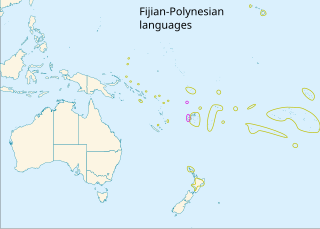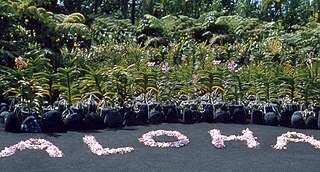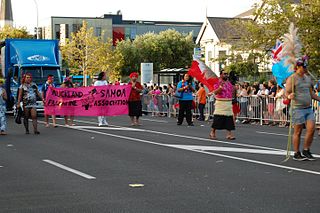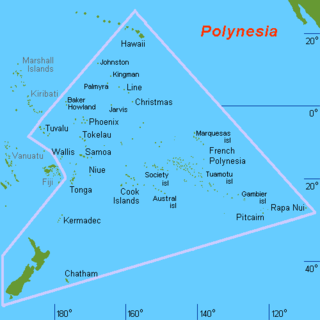Related Research Articles

The history of the Pacific Islands covers the history of the islands in the Pacific Ocean.

The Polynesian languages form a genealogical group of languages, itself part of the Oceanic branch of the Austronesian family.

Pacific Islanders, Pasifika, Pasefika, Pacificans or rarely Pacificers are the peoples of the Pacific Islands. As an ethnic/racial term, it is used to describe the original peoples—inhabitants and diasporas—of any of the three major subregions of Oceania.
The music of Polynesia is a diverse set of musical traditions from islands within a large area of the central and southern Pacific Ocean, approximately a triangle with New Zealand, Hawaii and Easter Island forming its corners. Traditional Polynesian music is largely an inseparable part of a broader performance art form, incorporating dance and recital of oral traditions; most literature considers Polynesian music and dance together. Polynesian music expanded with colonial European contact and incorporated instruments and styles introduced through a process of acculturation that continues to the present day. Although the European tradition of hymn-singing brought by Christian missionaries was probably the most important influence, others are evident; Hawaii's influential kī hōʻalu music incorporated the Spanish guitar introduced in the late 19th century, and later introduced the steel guitar to country music. Hip hop and R&B influences have created a contemporary Urban Pasifika music genre with a strong Polynesian identity and supported by the annual Pacific Music Awards in New Zealand.
Polynesians are an ethnolinguistic group of closely related ethnic groups who are native to Polynesia, an expansive region of Oceania in the Pacific Ocean. They trace their early prehistoric origins to Island Southeast Asia and form part of the larger Austronesian ethnolinguistic group with an Urheimat in Taiwan. They speak the Polynesian languages, a branch of the Oceanic subfamily of the Austronesian language family. The Indigenous Māori people constitute the largest Polynesian population, followed by Samoans, Native Hawaiians, Tahitians, Tongans and Cook Islands Māori

Aloha is the Hawaiian word for love, affection, peace, compassion and mercy, that is commonly used as a greeting. It has a deeper cultural and spiritual significance to native Hawaiians, for whom the term is used to define a force that holds together existence.

The traditional music of Tuvalu consists of dances, including fatele, fakanau and fakaseasea. The influence of the Samoan missionaries sent to Tuvalu by the London Missionary Society from the 1860s resulted in the suppression of songs about the traditional religions or magic and many songs were lost. As the influence of the missionaries diminished in the 20th century the traditional dances were revived and the siva dance tradition from Samoa also became popular.

Faʻafafine are people who identify themselves as having a third gender or non-binary role in Samoa, American Samoa and the Samoan diaspora. A recognised gender identity/gender role in traditional Samoan society, and an integral part of Samoan culture, faʻafafine are assigned male at birth, and explicitly embody both masculine and feminine gender traits in a way unique to Polynesia. Their behaviour typically ranges from extravagantly feminine to conventionally masculine.
Kia ora is a Māori-language greeting which has entered New Zealand English. It translates literally as "have life" or "be healthy", wishing the essence of life upon someone, from one speaker to the other. It is used as an informal greeting or farewell equivalent to "hi", "hello", or "goodbye" and can be used as an expression of thanks similar to "cheers". As a greeting of local origin, it is comparable to the term "g'day".
Reed Publishing (NZ) Ltd was one of the leading publishers in New Zealand. It was founded by Alfred Hamish Reed and his wife Isabel in 1907. Reed's nephew Alexander Wyclif Reed joined the firm in 1925. It was a New Zealand literature specialist and general titles publisher, releasing over 100 titles a year including a number of significant New Zealand authors such as Barry Crump, Janet Frame and Witi Ihimaera.
Sasa is a Samoan word for a particular group dance. The sasa can be performed by both males and females in a seated position or standing. Hand movements are used to depict activities taken from everyday life.

Napoleon A. Tuiteleleapaga (II) was a prominent figure of both Western and American Samoa. He was a lawyer, author, amateur poet and musician from Leone, Tutuila, American Samoa. He is best known for composing the American Samoan anthem, "Amerika Samoa".

Polynesia is a subregion of Oceania, made up of more than 1,000 islands scattered over the central and southern Pacific Ocean. The indigenous people who inhabit the islands of Polynesia are called Polynesians. They have many things in common, including language relatedness, cultural practices, and traditional beliefs. In centuries past, they had a strong shared tradition of sailing and using stars to navigate at night.
The Congregational Christian Church Samoa (CCCS) is an international evangelical Christian Church originally established in Samoa by missionaries of the London Missionary Society.

Tuvaluan mythology tells stories of the creation of the islands of Tuvalu and of the founding ancestors of each island. While on some of the islands there are stories of spirits creating the islands, a creation story that is found on many of the islands is that te Pusi mo te Ali created the islands of Tuvalu; te Ali is believed to be the origin of the flat atolls of Tuvalu and te Pusi is the model for the coconut palms that are important in the lives of Tuvaluans. The strength of this belief has the consequence that Moray eel are tapu and are not eaten.

Oceanian culture encompasses the collective and diverse customs and traditions of art, architecture, music, literature, lifestyle, philosophy, politics and religion that have been practiced and maintained by the many ethnic groups of the geographical region of Oceania since prehistory. Cultures of Oceania reflect not only that of the region's indigenous peoples, but also the cultures brought by European colonisation and the United States, particularly through mass culture such as cinema and TV. Oceania is commonly divided into four geographic sub-regions, characterized by shared cultural, religious, linguistic, and ethnic traits: Australasia, Melanesia, Micronesia, and Polynesia. Most Oceanian countries are multi-party representative parliamentary democracies, and tourism is a large source of income for the Pacific Islands nations.
Talofa Airways is a Samoan airline that offers flights within the Polynesian region. It started operations in August 2016 using two Rockwell 690B Turbo Commander aircraft. Talofa Airways is the third airline based in Samoa, after Samoa Air and Polynesian Airlines.

This is a gallery of current and historical flags of Polynesia.
References
- ↑ Duranti, Alessandro (2009). Linguistic anthropology. John Wiley and Sons. p. 217. ISBN 978-1-4051-2632-8 . Retrieved 8 July 2010.
- ↑ Léonard Drilë Sam, "Marques aspecto-temporelles et modales et structures d'actance du drehu, langue de Lifou (Nouvelle-Calédonie)", PhD dissertation, 2007.
- ↑ American Samoa Official Web Site